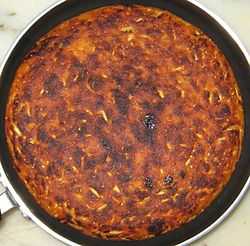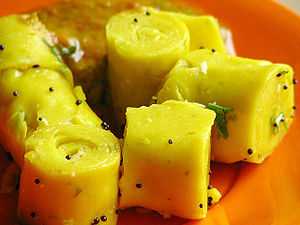Gujarati cuisine
 |
| This article is part of the series |
| Indian cuisine |
|---|
|
Regional cuisines
|
|
Ingredients / types of food |
|
See also
|
|
Related Cuisines
|
|
Gujarati cuisine (Gujarati: ગુજરાતી ભોજન) refers to the cuisine of Gujarat, India, a state in western India. Despite having an extensive coastline for seafood, it is primarily a vegetarian cuisine due to the influence of Jain vegetarianism and traditional Hinduism.[1][2] The typical Gujarati Thali consists of Rotli, Dal or Kadhi, Rice, and Shaak/Sabzi (a dish made up of different combinations of vegetables and spices, which may be spicy or sweet). Gujarati cuisine varies widely in flavour and heat, depending on a given family's tastes as well as the region of Gujarat they are from. North Gujarat, Kathiawad, Kachchh, and Surti Gujarat are the four major regions of Gujarat that all bring their own style to Gujarati food. Many Gujarati dishes are distinctively sweet, salty, and spicy at the same time.
Overview
Staples include homemade Khichdi (rice and lentil or rice and mung bean), and chaas (buttermilk) and pickles as side. Main dishes are based on steamed cooked vegetables with different spices and dals that are added to a vaghar, which is a mixture of spices sterilized in hot oil that varies depending on the main ingredient. Salt, sugar, lemon, lime, and tomato are used frequently to prevent dehydration in an area where temperatures reach 50°C (122°F) in the shade. It is common to add a little sugar or jaggery to some of the sabzi/shaak and dal. The sweet flavour of these dishes is believed to neutralize the slightly bland taste of the vegetables.
The cuisine changes with the seasonal availability of vegetables. In summer, when mangoes are ripe and widely available in market, for example, Keri no Ras (fresh mango pulp) is often an integral part of the meal. The spices used also change depending on the season. Garam Masala and its constituent spices are used less in summer. Regular fasting, with diets limited to milk, dried fruits, and nuts, are commonplace.
In modern times, some Gujaratis have become increasingly fond of very spicy and fried dishes. There are many chefs who have come up with fusions of Western and Gujarati food. Gujaratis are predominantly vegetarians even though pockets of the state consume chicken, beef and fish.
Bajra Roti is a plain flat bread made from flour having nutritional value similar to other foods based on flours.[3] Common meals in villages near Saurashtra during the cold winters consists of thick Rotis, termed Bhakri, made of wheat flour, garlic chutney, onion, and chaas.
Sweets (desserts) made from such ingredients as local sugarcane, jaggery,milk,almonds, and pistachios were originally served at weddings and family occasions as an energy booster for relatives traveling long distances to attend.[citation needed] These days, sweets served as part of a thali are more typically made from milk, sugar, and nuts. "Dry" sweets such as Magas and Ghooghra are typically made around celebrations, such as weddings, or at Diwali[citation needed]
Gujarati cuisine is also distinctive in its wide variety of farsan — side dishes that complement the main meal and are served alongside it. Some farsan are eaten as snacks or light meals by themselves.
Gujaratis will often refer to Dal-Bhat-Rotli-Saak as their everyday meal. For special occasions, this basic quartet is supplemented with additional shaak, sweet dishes, and farsan. A festive Gujarati thali often contain over a dozen items. Dietary rules restrict the permissible combination of dishes.[citation needed] For example, if kadhi is to be served, then a lentil preparation such as chutti dal, vaal, or mug ni dal will also be included. The sweet dish accompanying kadhi will likely be milk or yogurt–based, like doodhpak or shrikhand. However, a yogurt-based raita would not be served with such a meal. Festive meals based on dal will typically have a wheat-based sweet dish like lapsi or ladoo as the sweet accompaniment. Many Gujarati families make and consume moong dal in their diet on Wednesdays. There are established combinations of spices that some believe to facilitate digestion, that are eaten with different foods.
In coastal Gujarat, the Kharwa community has developed a cuisine consisting of fresh and dried fish. Common seafood are pomfrets, khandwas, gedadas, surmai, prawns, crabs, lobster. and narsinga (calamari).
List of Gujarati dishes
Breads
- Bajri no Rotlo: Thick millet flour flatbread usually grilled over coals.
- Bhakri: Made with whole wheat flour, thicker than Rotli, crispy.
- Phulka rotli (Also called Rotli or Chapati): Made with whole wheat flour, rolled thin.[4]
- Juvar no Rotlo: Thick sorghum flatbread.
- Parotha: Fried whole wheat flatbread.
- Puran Poli (Also known as Vedmi): Whole wheat bread filled with sweet moong dal filling usually made for special occasions.
- Puri: Made with whole wheat flour, deep fried.
- Thepla/Dhebra: Made with a mixture of flours, pan fried, mildly spiced, usually contains shredded vegetables.
- Pooda: Made with a mixture of flours, pan fried.
Rice
In addition to plain rice, Gujarati cuisine also includes rice based dishes such as:
- Biranj: Steamed rice flavoured with saffron, sugar, and dried fruit.
- Khatta-Mittha Bhaat (Sour and Sweet Rice): Rice, boiled with potatoes and spices, yellow in colour and accompanied with lemon peel.
- Doodhpak: Rice pudding made by boiling rice with milk and sugar, and flavoured with cardamom, raisins, saffron, cashews, pistachios, or almonds. It is typically served as a dessert.
- Khichdi (Rice & a Dal): Cooked like porridge accompanied with ghee, yogurt, and pickle.
- Pulao (Rice with vegetables)
- Khichu: Kneaded rice flour made by heating it with water, salt, green chillies, and cumin.
Vegetables (Shaak/Subzi)
- Bateta nu Shaak Curry)
- Bateta Sukhi Bhaji (Dry Potato Curry)
- Bharela Bhinda (Stuffed dry Okra)
- Bharela Karela (Stuffed dry Bitter Melon)
- Bhinda nu Shaak (Dry Okra Curry)
- Vatana Bateta nu Shaak (Potato and Peas Curry)
- Chola nu Shaak (Black eyed peas Curry)
- Dhana capsicum nu Shaak (Dry Coriander, capsicum and chickpea flour curry)
- Dudhi Bateta nu Shaak (Bottle Gourd and Potato Curry)
- Dudhi Chana Ni Daal nu Shaak (Bottle Gourd and Split Black Chickpea Curry)
- Dudhi Ganthia nu Shaak (Bottle Gourd)
- Dudhi Mag ni Dal nu Shaak (Bottle Gourd and Mung Bean Curry)
- Dudhi nu Shaak (Bottle Gourd Curry)
- Fansi ma Dhokli nu Shaak (French Bean Curry with Dumplings)
- Fansi nu Shaak (Dry Green bean Curry)
- Ganthoda nu Shaak
- Gathia nu Shaak
- Guvar nu Shaak (Cluster Beans Curry)
- Kadhi (Curry made from buttermilk chhash and gram fluor, usually either sweet or tangy)
- Kanda Bateta nu Shaak (Onion and Potato Curry)
- Karela nu Shaak (Bitter Melon Curry)
- Kobi Bateta nu Shaak (Dry Cabbage and Potato Curry)
- Mag nu shaak (Mung Bean Curry)
- Methi nu Shaak (Fenugreek)
- Panchkutiyu Shaak (Five Vegetable Curry consisting of Ridge Gourd, Potato, Bottle Gourd, Eggplant, and Green Peas)
- Parwal Bateta nu Shaak (Pointed Gourd and Potato Curry)
- Ringan nu Shaak (Eggplant)
- Ringna no Olo (Roasted Eggplant's mashed Curry)
- Sev Tameta nu Shaak (Curry made of Green (Unripe) Tomatoes)
- Tameta Bateta nu Shaak (Tomato and Potato Curry)
- Tindora nu Shaak (Ivy Gourd Curry)
- Undhiyu: A mixed vegetable casserole that is traditionally cooked upside down underground in earthen pots fired from above. This dish is usually made of the vegetables that are available on the South Gujarat coastline during the winter season, including (amongst others) green beans, unripe banana, muthia, and purple yam. These are cooked in a spicy curry that sometimes includes coconut. Surti Undhiyu is a variant that is served with puri at weddings and banquets. Again it is a mixed vegetable casserole, made with red lentils and seasoned with spices, grated coconut, and palm sugar in a mild sauce. It is garnished with chopped peanuts and toasted grated coconut, and served with rice or roti. This dish is very popular all over Gujarat, and most Gujarati families eat it at-least once a year on Makar Sankranti.
- Vadi Papad Nu Shaak
Side dishes (Farsan)

Farsan are side dishes in Gujarati cuisine.
- Bhajiya (Deep fried savoury snacks. A popular variety is Pakora.)
" LOCHO" (famous surti variety made from chickpea flour )
- Chaat (A mixture of potato pieces, Crispy fried bread, and Spices topped with chutney, cilantro, and yogurt.)
- Dahi Vada (Fried dumplings soaked in yogurt and topped with salt, cumin, and cayenne pepper.)
- Dhokla (Steamed cake made primarily of rice flour.)
- Handvo (Steamed cake made of rice flour, Various beans, yogurts, and calabash.)
- Kachori (A deep fried dumpling made of flour and filled with a stuffing of Yellow moong dal, black pepper, cayenne pepper, and ginger.)
- Khaman (Steamed cakes made out of gram flour, garnished with Green chili pepper and cilantro.)
- Khandvi (Roll made of gram flour and yogurt topped with mustard seed, cilantro, and Grated coconut.)
- Khichu (A thick porridge-like mixture made of rice flour and seasoned with cumin seeds. Once prepared, the mixture is often topped with oil, cayenne pepper, and salt.)
- Lilva Kachori (A variety of kachori made with pigeon peas.)
- Methi na Gota (Fried fenugreek Dumplings)
- Muthia (Steamed dumpling made of gram flour, fenugreek, salt, turmeric, and cayenne pepper. The steamed dumpling can also be stir fried with Mustard Seed.)
- Pani Puri (A round hollow flatbread that is fried crisp and filled with potato, and Black Chickpeas and topped with Water seasoned with mint and Green chili pepper, and tamarind chutney.)
- Patra (Taro Leaves, coated with gram flour, rolled and steamed. Sometimes, the steamed roll is sliced and stir-fried with mustard seed and Grated coconut.)
- Sev Khamani (Khaman topped with crispy, fried gram flour.)
- Surat no Locho
- Vegetable Handva (Grill Handva - Serve it hot either with chutney or tomato sauce or pickle.)
- Dal vada, Vaati dal na bhajiya
Snacks (Nasta)
Most nasta (singular nasto) are deep fried and made with Gram Flour.
Daal (pulses)
- Moong Daal
- Meethi (Sweet) Kadhi
- Kadh (an intermediate between kadhi and daal)
- Tuer daal
- Mix daal
Mithai (sweets)
- Adadiya
- Jadariyu
- Sutarfeni
- Kansar
- Maisub
- Halvasan
- Malpua
- Keri no ras
- Basundi
- Ghari
- Ghughra
- Ghebar or Ghevar
- Son Papdi
- Magas (or Magaj)
- Sukhadi
- Monthar
- Gud papdi (Gol papdi)
- Ronvelia
- Penda
- Barfi
- Ladu
- Shiro
- Ghooghra
- Jalebi
- Shrikhand
- Laapsi
- Doodhpak
- Shakkarpara
- Kopra paak
- Gaajar Halwo
- Dudhi no Halwo Gur
- Kaju Katri
- Gulab Jambu
Condiments
- Chutney
- Raita
- Athanu/Pickles
- Papad
Spices and seasonings
- Kokum
- Ambli (Tamarind)
- Gaur (Jaggery)
- Chaat Masala
- Hardar (Turmeric powder)
- Kothmir (Coriander)
- Elaichi (Cardamom)
- Garam Masala (Mix of dry spices, roasted and made powder)
- Hing (asafoetida)
- Jeeru (cumin)
- Kesar (saffron)
- Marchu (chillies)
- Lal Marchu
- Methi (Fenugreek - leaves and seeds)
- Phoodino (mint)
- Soonth (ginger powder)
- Laving (cloves)
- Mitho Limbdo (curry leaves)
See also
References
- ↑ Dalal, p. 4
- ↑ Bradnock , p. 54
- ↑ Livestrong
- ↑ http://www.ysu.edu/stu_org/iiso/indianrecipes.htm
- Tarla Dalal (1999). The Complete Gujarati Cook Book. Sanjay & Co. ISBN 81-86469-45-1.
- Robert Bradnock; Roma Bradnock (2001). Rajasthan & Gujarat handbook: the travel guide. Footprint Travel Guides. ISBN 190094992X.
External links
| Wikimedia Commons has media related to Cuisine of Gujarat. |
| ||||||||||||||||||||||||||||||






